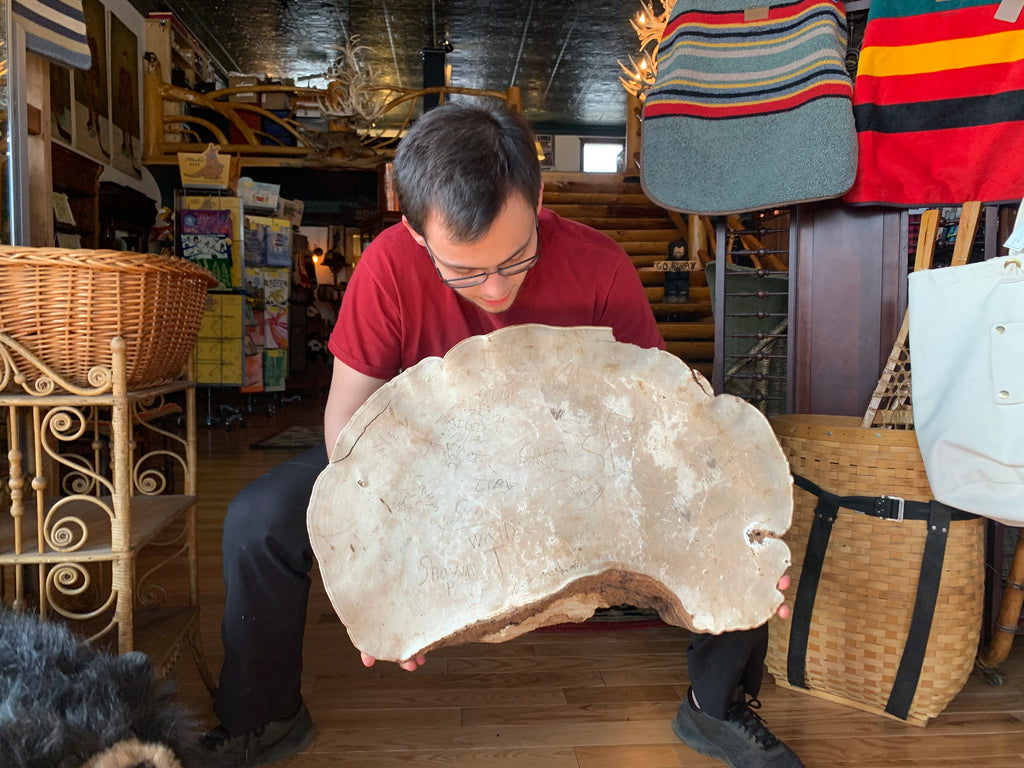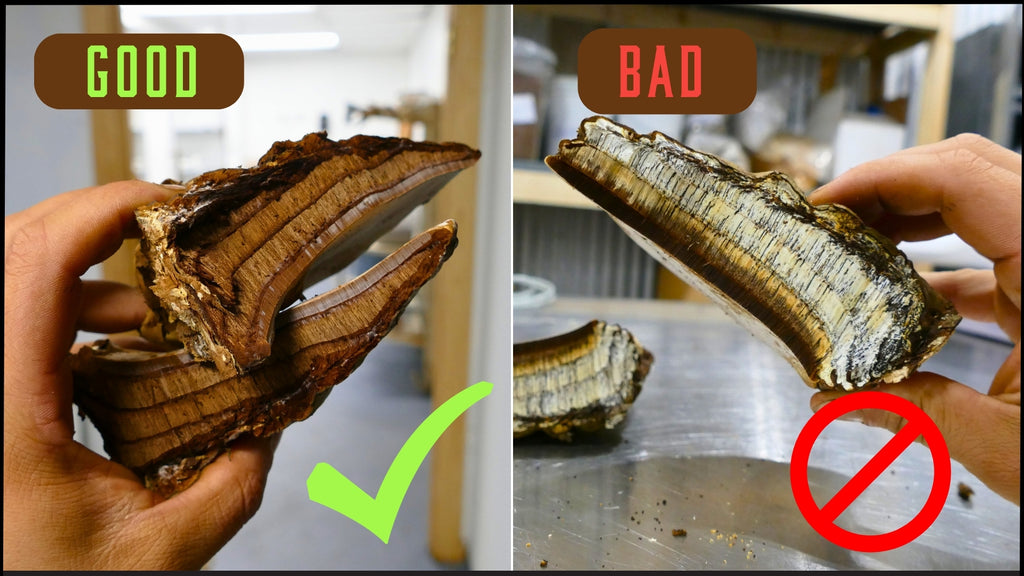The Artist’s Conk, Ganoderma applanatum, is found in almost every state in America, all across Canada, and many other world continents. This polypore mushroom is typically found on hardwood logs or stumps. The Artist’s Conk is a perennial fungus, which allows it to grow larger with each year. Much like a tree, the mushroom’s age can be determined by cutting it in half and counting the number of pore layers.
Ganoderma Applanatum is a wood-decay fungus, causing a rot of the heartwood in a variety of trees. A wood-decay or xylophagous fungus is any species of fungus that digests moist wood. It is believed this contributes to the many beneficial compounds found in polypores such as Artist Conk. As the tree is broken down and digested, beneficial compounds like polyphenols, polysaccharides and triterpenes are accumulated by the mushroom, creating conks full of mycological magic.
The Artist’s Conk gets its name from the natural canvas on the under surface of the fruiting body. When this surface is etched into, the brown bruising is in sharp contrast to the white color of the rest of the body, giving you the ability to create beautiful, natural drawings. On that note, when harvesting this mushroom for artistic purposes, be very careful so as not to cause unintentional bruising to the white canvas surface. The surface is very sensitive and it is easy to bruise with your fingers!
In addition to its use as a canvas, it offers a wealth of health benefits when consumed as a tincture or tea. A lot of these benefits are very similar to its cousin, Ganoderma lucidum, commonly known as “red reishi” mushroom (which you can read all about here). While artist’s conk shares some benefits with red reishi, it also touts its own unique benefits.
Artist Conk: One of many Ganoderma Mushrooms

The Artist's Conk belongs to the genus Ganoderma. This genus also contains Red Reishi, another medicinal polypore that we work with regularly. Ganoderma is derived from the Greek word ganos meaning shiny, and derma meaning skin, a reference to the many species of ganoderma with a shiny outer sheen. Ganoderma mushrooms have been used for hundreds of years as traditional medicine, with use in ancient China being detailed in descriptions dated to the first and second centuries AD.
Like all polypores, Artist conk contains a range of beneficial compounds. One such group of compounds that might sound familiar is beta-glucan. Beta-glucan polysaccharides are powerful immunomodulators, working in a number of ways to help improve immune function. Another group of compounds present in Ganoderma Applanatum are triterpenes. Triterpenes have been known to support digestive and hepatic function, aid in the assimilation of nutrients, and the elimination of waste products in the body. In addition to beta-glucans and triterpenes, Artist Conk has a myriad of other polysaccharides, sterols, and polyphenolic compounds that likely contribute to its medicinal properties.
Artist Conk for Enhancing Libido
Artist conk has also been shown to be useful for cardiovascular health due to its ability to support nitric oxide synthase. Nitric oxide is a vasodilator which increases blood flow through the arteries, and also plays a pivotal role in cardiac function, peristalsis and sexual arousal in both men and women. A study from 2005 notes that extracts of Ganoderma applanatum significantly increased nitric oxide synthesis compared to the control.
Respiratory Support
Artist’s Conk has been used historically in North America, Asia and Africa to support the respiratory system. Artist’s conk is said to reduce heat and improve flow of Qi into and through the lungs. In TCM, artist’s conk is also used as an immune system tonic - one to be taken in preparation for cold and flu season. Christopher Hobbs PhD, clinical herbalist, licensed acupuncturist and author of many herbalism books including, Medicinal Mushrooms The Essential Guide, recommends Artist’s Conk to increase respiratory resilience.
Artist’s Conk’s respiratory-supporting properties can likely be attributed to its ganoderic acid content. Ganoderic acid is a triterpene that has shown positive effects on distressed respiratory systems in several studies, conducted on both humans and mice. In addition to this, ganoderic acids have also been shown to support a healthy blood oxygen level. Sherpas, climbing guides who assist people in traversing to some of the tallest mountains in the world, use reishi mushrooms in preparation for their journeys.
Pain Management
In a study conducted in 2021, but on mice instead of rats, Ganoderic acids from G. applanatum displayed promising potential for supporting pain management in rodents. Ganoderic acids are a class of closely related triterpenoids found in Ganoderma mushrooms. The two most well described ganoderic acids out of the many that have been identified and characterized are ganoderic acids A and B. Some ganoderic acids have been found to possess biological activities including hepatoprotection, anti-tumor effects, and 5-alpha reductase inhibition. Ganoderic acids A, B, G and H and compound C6 are antinociceptive, meaning they can act as pain inhibitors in animal studies. Note that Ganoderic acids are not water soluble, and an alcohol extract would be required in order to elicit any benefits from them.
Immune Support
Ganoderma applanatum has displayed immunomodulatory activity. In a 2016 study, rainbow trout were given 250, 500, and 1,000mg/kg supplements 4 times daily for a 45-day period. Immunologic parameters were then tested and showed that the numbers of red and white blood cells, hemoglobin, hematocrit, monocytes, and neutrophil levels had increased significantly for all the treated fish, and especially with the 1,000mg/kg dose. The researchers concluded Artist’s Conk has the potential to activate immunologic parameters. In a 2011 study, a compound was isolated from G. applanatum and shown to inhibit the synthesis and excretion of CXCL10, a protein which contributes greatly to chronic inflammatory conditions. The compound was designated Ganodermycin and has potential in treating inflammatory diseases, which suggests that G. applanatum has anti-inflammatory activity.
Antioxidant Activity
When extracted or used as a tea, the Artist’s Conk has been found to have significant antioxidant activity. In a 2012 study, researchers tested the antioxidant activity of G. applanatum and other mushrooms, where G. applanatum exhibited the highest free-radical scavenging ability, inhibition of lipid peroxidation, and reducing ability. This antioxidant activity strongly correlated to the levels of alpha-glucans, an anticancer and immunomodulatory polysaccharide, and phenolic compounds. Another study researching Artist’s Conk in combination with black tea leaf extracts found that the combination had a strong positive effect on the level of phenolic-type antioxidants.
Liver and Kidney Health
In addition to the intriguing findings above, artist’s conk has a few more compelling studies to ponder. In one study conducted in 2021 on Wistar rats, both aqueous and methanol extracts of artist’s conk were shown to have promising effects on liver enzymes and showed strong potential for hepatoprotective properties. In a 2017 study, artist’s conk extracts were administered to hyperuricemic mice with a positive control of allopurinol and benzbromarone. The results showed that G. applanatum displayed, “outstanding hypouricemic effects,” in mice without the renal toxicity that is associated with benzbromarone use. As you can see, the studies performed on rodents using Artist’s Conk are incredibly promising, but more research needs to be performed before making definitive conclusions on G. applanatum’s effects on human health.
Harvesting Artist Conk on Your Own

Something to be aware of for anyone looking to harvest this mushroom for their own use or tincture-making, is that a substantial percentage of Artist Conk Mushrooms wil be fraught with mold. The only way to tell whether or not any Artist Conk Mushroom is actually usable is to forcefully split it open in order to analyze its internal layers of annual growth. If all layers are brown, the mushroom is entirely good and usable. More often however, there is usually at least one or more spoiled layers that will appear white, which indicates that these layers have been overtaken by mold.
If you see layers of white when you break open the Artist Conk, you should manually remove these moldy white layers because they will not possess the same qualities as the brown layers, and they may even be (mild) toxins for certain sensitive individuals. This is a tedious process, so if you find yourself about to crack open an Artist Conk, we wish you good luck, and we urge you to harvest responsibly.
There is no easy solution for the fact that you must break apart the mushroom before even knowing if it is usable, and when a harvest goes to waste, at least make a point to carry the mushroom throughout the forest, as it is always spore-bearing, so at the very least, you can turn your efforts into a simple act of reciprocity.
Artist's Conk Tincture - 4oz
30 servings, lasts one month.
Artist's Conk Tincture - 16oz
120 servings, lasts four months.
About The Author
Garrett Kopp is the 25 year old Chaga visionary and founder of Birch Boys, Inc., a company well-known for its assortment of teas, tinctures, and extracts from healing wild fungi. Kopp grew up in the Adirondack Mountains, where he naturally developed a broad passion for the wild northern forests of New York. He began to specialize and narrow this passion toward Chaga after a freak accident where he helped himself to a cup of what appeared to be iced tea in his Grandmother’s refrigerator, who had started harvesting Chaga and brewing it on her own amidst a battle with stage 4 pancreatic cancer. Soon thereafter, Kopp and his grandmother expanded their Chaga harvesting activities to local farmer's markets, where they discovered significant demand for the fungus and its powerful ability to help everyday people.
These entrepreneurial efforts landed Kopp acceptance into Clarkson University’s early entrance program, the Clarkson School, where he studied Engineering & Management and Innovation & Entrepreneurship. Several years and hundreds of research hours later, Kopp returned to his hometown. Having shipped to over 20,0000 individuals throughout all 50 states, Birch Boys has organically grown into a nationally recognized online brand . Kopp is proud to have built a vertically integrated supply chain, sustainably sourcing the fruits of tree-borne fungi from over 220,000 leased acres of leased private land in the Adirondack park, where it is carefully harvested by hand before being dried, processed, and extracted with love, at his fungi factory in none other than Tupper Lake, NY.
Sources
Manayi, A. Vazirian, M. Zade, FH. Tehranifard, A. Immunomodulation Effect of Aqueous Extract of the Artist's Conk Medicinal Mushroom, Ganoderma applanatum (Agaricomycetes), on the Rainbow Trout (Oncorhynchus mykiss). 2018. https://www.ncbi.nlm.nih.gov/pubmed/27910760
Kumaran, S. Pandurangan, AK. Shenbhagaraman, R. Esa, NM. Isolation and Characterization of Lectin from the Artist's Conk Medicinal Mushroom, Ganoderma applanatum (Agaricomycetes), and Evaluation of Its Antiproliferative Activity in HT-29 Colon Cancer Cells. 2017. https://www.ncbi.nlm.nih.gov/pubmed/29199567
Tsiveleva, O. Pankratov, A. Misin, V. Zavyalov, A. Tsymbal, O. Yurasov, N. Nikitina, VE. Antioxidant Properties of the Artist's Conk Medicinal Mushroom, Ganoderma applanatum (Agaricomycetes), upon Cultivation with para-Substituted Phenolic Compounds and Tea Leaf Extracts. 2018. https://www.ncbi.nlm.nih.gov/pubmed/29953351
Kozarski, Maja, et al. “Antioxidative Activities and Chemical Characterization of Polysaccharide Extracts from the Widely Used Mushrooms Ganoderma Applanatum, Ganoderma Lucidum, Lentinus Edodes and Trametes Versicolor.” Journal of Food Composition and Analysis, Academic Press, 28 Feb. 2012,
Jeong, Yong-Tae, et al. “Ganoderma Applanatum: a Promising Mushroom for Antitumor and Immunomodulating Activity.” Phytotherapy Research, vol. 22, no. 5, 2008, pp. 614–619., doi:10.1002/ptr.2294.
Ma, Jieqiong, et al. “Cellular and Molecular Mechanisms of the Ganoderma Applanatum Extracts Induces Apoptosis on SGC-7901 Gastric Cancer Cells.” Cell Biochemistry and Function, vol. 29, no. 3, 2011, pp. 175–182., doi:10.1002/cbf.1735.
Jung, Mathias, et al. “Ganodermycin, a Novel Inhibitor of CXCL10 Expression from Ganoderma Applanatum.” The Journal of Antibiotics, vol. 64, no. 10, 2011, pp. 683–686., doi:10.1038/ja.2011.64.




Comments (5)
Hey there I’ve tried to get the 20% coupon applied after adding two different emails but never received an email with the code. Would love to buy a lot of your products. Needing help figuring out the code
Can you take artist’s conk tincture for pain if you take blood pressure medication?
Good morning Garrett, I currently use your fungi 5 tincture, would adding Artists Conk tincture give me additional benefits or duplicate what I am already getting?
How do you maintain, or care for an artist conk, will it freeze?
I have an artist conk mushroom thatHasThree deer on itThat is probably hundreds of years old